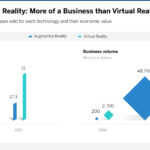Augmented Reality vs. Virtual Reality: when the shy brother outpaces the popular one
Virtual Reality has been stealing the show until now, but Augmented Reality is on the brink of becoming a huge business. Success stories such as Pokemon Go and Snapchat have shown the technology’s potential, causing Facebook to spring into action.

You’ve probably been coming across, or reading, the many articles that have been popping out everywhere in recent months praising the virtues of Virtual Reality, the technology that both the media and tech giants have singled out as the next big thing in the coming years. However, another alternative reality that has been making less media noise, Augmented Reality, might become, at least in the short-term, the new gold mine that all technology companies are searching for.
Figures and forecasts on the sales of the headsets required to enjoy these two technologies offer a clear idea of where things may be heading. Last year, sales of the glasses that implant digital images on the physical world – that’s how we could define Augmented Reality - reached $200 million, compared to the over $2.1 billion in Virtual Reality glasses. However, by 2021, sales of Augmented Reality hardware are expected to skyrocket to $48.7 billion, compared to $18.6 billion dollars in Virtual Reality headsets.

What are the factors behind this surge in Augmented Reality? According to analysts at the specialist consulting firm IDC, who gathered all these data, the hefty price tag of Augmented Reality headsets – in some cases exceeding $1,000 - will not prevent the commercial success of the technology. In addition, they predict that the use of these devices will become commonplace in professional environments much sooner than among consumers. According to IDC, the textile, transportation and healthcare industries will be some of the sectors that will capitalize the most on these technologies.
While Augmented Reality goggles wait in line for their turn, the technology is already becoming increasingly popular, thanks to a range of applications that require only a decent smartphone. As Facebook founder Mark Zuckerberg recently posted: "We all know where we want to take augmented: We want lightweight glasses or contact lenses capable of overlaying all kinds of digital content and information on the physical world. But in the last couple of years, we've started seeing some primitive examples of Augmented Reality on smartphones."
Facebook has quickly sprung from thought to action, releasing a new range of Augmented Reality filters to respond to those "primitive examples." Who were the pioneers? Basically two: Pokemon Go, which sparked a worldwide craze last summer, and Snapchat. The social network of disappearing messages has also done much to boost the technology’s popularity, and took a step further in April by refining its tools to allow users to apply Augmented Reality layers to their videos.
On the other hand, Virtual Reality is ahead in terms of support from major technology companies: Rift by Oculus, a company that Facebook bought for $2 billion in 2014, Sony’s PlayStation VR and HTC’s Vive are leading the way. But their commercial strategies are raising concerns.
The first hurdle is getting the price right: today, quality Virtual Reality remains too expensive, and cheap VR fails to deliver a reasonably satisfactory user experience. As the IDC analysts point out, inexpensive VR glasses such as Google Cardboard, which offer a disappointing first-time experience, may cause consumers to permanently turn their backs on the technology. Also, Virtual Reality needs its own massively popular application, the equivalent to Pokemon Go. But, is all the pessimism justified? IDC estimates that between 2016 and 2021 the VR headset market will increase almost ninefold – nothing to be pessimistic about.